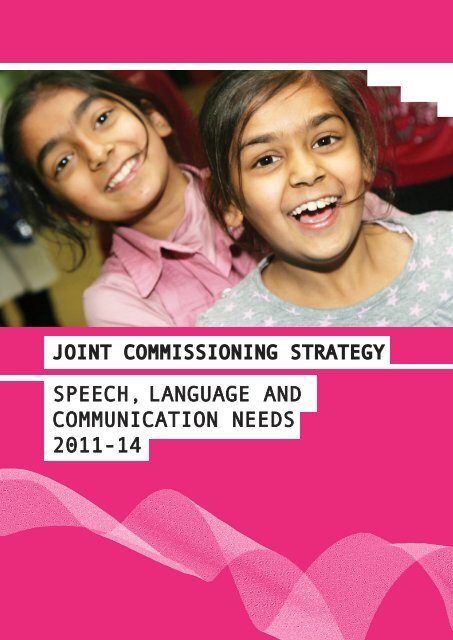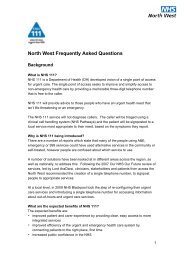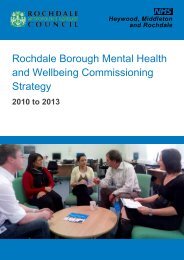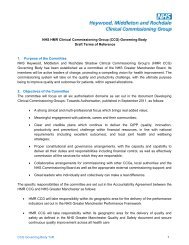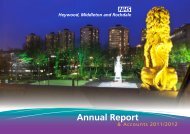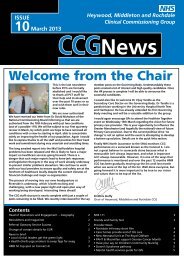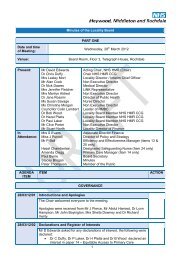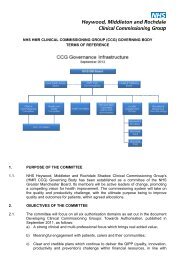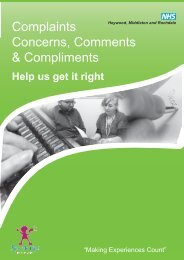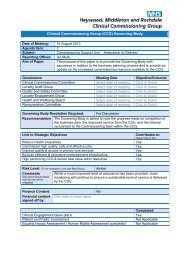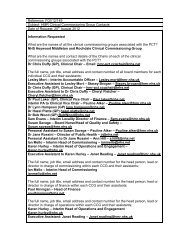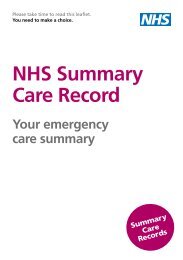Speech, Language and Communication Needs Joint ...
Speech, Language and Communication Needs Joint ...
Speech, Language and Communication Needs Joint ...
Create successful ePaper yourself
Turn your PDF publications into a flip-book with our unique Google optimized e-Paper software.
JOINT COMMISSIONING STRATEGY<br />
SPEECH, LANGUAGE AND<br />
COMMUNICATION NEEDS<br />
2011-14
DOCUMENT HISTORY<br />
Version<br />
Approving<br />
Committees<br />
Final<br />
NHS HMR Locality Board - May 2011<br />
Children , School <strong>and</strong> Families <strong>Joint</strong> Strategic Commissioning Group<br />
Author:<br />
Karen Kenton - Associate Director Commissioning Children & Maternity<br />
Support by <strong>Speech</strong>, <strong>Language</strong> <strong>and</strong> <strong>Communication</strong> <strong>Needs</strong> Project Group<br />
Dr Sean Pert - HMR Community Healthcare<br />
Alison Drake - HMR Community Healthcare<br />
Jan Stothard - RMBC<br />
Maria Boyle - RMBC<br />
Kate Charlton - Schools<br />
2
CONTENTS<br />
Preface 4<br />
Vision 5<br />
Principles 6<br />
Introduction 7<br />
<strong>Needs</strong> Assessment 10<br />
Current Service Provision 16<br />
Finance <strong>and</strong> Funding 20<br />
Current Performance <strong>and</strong> Outcomes 22<br />
Best Practice 23<br />
Service Delivery Model 26<br />
Priorities 28<br />
Action Plan 29<br />
Governance 30<br />
References 31
PREFACE<br />
“The ability to communicate is an essential life skill for all children <strong>and</strong> young people in the 21st century.<br />
It is at the core of all social interaction. With effective communication skills, children can engage <strong>and</strong><br />
thrive. Without them, children will struggle to learn, achieve, make friends <strong>and</strong> interact with the world<br />
around them. The centrality of communication is not simply a personal statement of value. It is a formal,<br />
public <strong>and</strong> multi-lateral declaration by UNICEF, UNESCO <strong>and</strong> the World Health Organisation, which list<br />
communication as one of ten core life skills. <strong>Communication</strong> is a fundamental human right.” (Bercow<br />
2008).<br />
In 2008 the government published ‘The Bercow Report: A Review of Services for Children <strong>and</strong> Young<br />
People (0-19 years) with <strong>Speech</strong>, <strong>Language</strong> <strong>and</strong> <strong>Communication</strong> <strong>Needs</strong>’. This was quickly followed by<br />
‘Better <strong>Communication</strong>: An Action Plan’ which proposed the establishment of 20 commissioning pathfinders<br />
to explore the joint commissioning of provision for SLCN across the range of universal, targeted<br />
<strong>and</strong> specialist services.<br />
One of the greatest challenges for meeting SLCN is the range of need across the client group <strong>and</strong> the<br />
great variability in models of intervention. Children with SLCN are a significant concern for families <strong>and</strong><br />
educators, with a prevalence of 7% of 5 years olds <strong>and</strong> as much as 50% in socio-economic deprived<br />
populations such as Rochdale. Research undertaken within the borough showed that at one nursery<br />
only 5 out of 52 (9.6%) had age appropriate SLC skills.<br />
SLCN do not represent a single disability that can be easily recognised <strong>and</strong> treated but are present across<br />
the range of disabilities, as well as existing as a discreet developmental difficulty in the context of<br />
adequate skills in other developmental areas. SLCN therefore presents a considerable challenge for<br />
service commissioners <strong>and</strong> providers.<br />
Rochdale Borough Children’s Trust has recognised the importance of speech, language <strong>and</strong> communication<br />
in enhancing the outcomes <strong>and</strong> future life chances of children <strong>and</strong> young people living in the<br />
Borough, <strong>and</strong> has reflected this in the Borough’s Children <strong>and</strong> Young People’s Plan.<br />
2011 is the National Year of <strong>Speech</strong>, <strong>Language</strong> <strong>and</strong> <strong>Communication</strong>, <strong>and</strong> this strategy reinforces the<br />
commitment of all partners to work together to improve speech, language <strong>and</strong> communication (SLC)<br />
<strong>and</strong> to reduce the inequalities in outcomes that children <strong>and</strong> young people experience as a result of poor<br />
SLC skills.<br />
4
VISION<br />
We want to see:<br />
● Children entering school with sufficiently developed speech, language <strong>and</strong><br />
communication skills to enable them to learn.<br />
● Children <strong>and</strong> young people with additional SLCN receiving the support they need,<br />
when <strong>and</strong> where they need it.<br />
● Children <strong>and</strong> young people growing up <strong>and</strong> learning in ‘communication rich’<br />
environments.<br />
● A diverse range <strong>and</strong> mix of service providers with a capable <strong>and</strong> confident workforce,<br />
equipped with the skills <strong>and</strong> experience necessary to support the SLCN of children <strong>and</strong><br />
young people.<br />
● A whole systems approach to strategic planning <strong>and</strong> service delivery.<br />
● The participation of children, young people, families <strong>and</strong> all relevant stakeholders in<br />
service development<br />
5
PRINCIPLES<br />
This strategy has been developed taking account of the following principles:<br />
● <strong>Speech</strong>, language <strong>and</strong> communication are ‘everybody’s business’<br />
● Children <strong>and</strong> young people should have equal access to a range of high quality services<br />
● All children within the borough of Rochdale achieve the best possible outcomes, during<br />
childhood <strong>and</strong> adolescence to provide a solid foundation for adulthood.<br />
● High quality, evidence based <strong>and</strong> timely interventions are provided<br />
● Children <strong>and</strong> their families are recognised as equal partners <strong>and</strong> supported to identify their<br />
needs <strong>and</strong> access appropriate services<br />
● There is close collaboration between all services, settings <strong>and</strong> agencies to ensure close<br />
working relationships, working across organisational boundaries <strong>and</strong> the development of best<br />
practice<br />
● Commissioners <strong>and</strong> providers across all sectors, work in partnership to deliver integrated<br />
services for children <strong>and</strong> young people<br />
● All children <strong>and</strong> families have a right to receive appropriate services, irrespective of ethnicity,<br />
religion, disability, sexuality, gender or socio-economic status.<br />
● Services will safeguard <strong>and</strong> promote the well being of children <strong>and</strong> young people<br />
● Services will be delivered within available resource <strong>and</strong> deliver best value, <strong>and</strong> within the<br />
QIPP framework<br />
6
INTRODUCTION<br />
PURPOSE<br />
This strategy sets out how Rochdale Metropolitan Borough Council <strong>and</strong> NHS Heywood, Middleton<br />
<strong>and</strong> Rochdale intend to jointly commission a range of provision to support speech, language <strong>and</strong><br />
communication needs within the context of an integrated, whole systems approach to service delivery.<br />
The aims of the strategy are:<br />
● To describe SLCN needs within the Rochdale Borough, <strong>and</strong> review existing provision<br />
● To identify best practice at national <strong>and</strong> local levels<br />
● To describe a joint service delivery model that will ensure high quality <strong>and</strong> best value<br />
● To identify how partners intend to jointly commission services<br />
● To identify key priorities for action <strong>and</strong> implementation<br />
It seeks to:<br />
● Develop provision across the full range of SLCN needs for children <strong>and</strong> young people<br />
● Encourage a range of providers from across the public, private <strong>and</strong> voluntary sectors to support the<br />
development of SLCN services<br />
● Develop the workforce to be able to support SLCN<br />
● Maximise the use of existing available resources supporting SLCN through partnership working<br />
● Consult with children, young people <strong>and</strong> their families, <strong>and</strong> the range of stakeholders.<br />
THE VALUE OF SPEECH LANGUAGE AND COMMUNICATION SKILLS<br />
<strong>Speech</strong>, language <strong>and</strong> communication skills are key to a child’s social <strong>and</strong> educational success. Making<br />
friends, learning <strong>and</strong> enjoying family life are all activities where communication skills are central.<br />
Educational attainment <strong>and</strong> future employment prospects are all built upon good communication skills.<br />
There is a wealth of evidence showing that children <strong>and</strong> young people who have SLCN are placed at<br />
significant risk of failing to achieve their potential (Bercow 2008, Marmot 2010). This is not only a<br />
concern for the child <strong>and</strong> their immediate family. Poor outcomes for children lead to a risk of higher<br />
unemployment, mental health issues <strong>and</strong> even risk of antisocial <strong>and</strong> criminal behaviour. This is why SLCN<br />
is everybody’s concern.<br />
Early intervention <strong>and</strong> sustained support for children <strong>and</strong> young people with SLCN are therefore cost<br />
effective for local services <strong>and</strong> society as a whole, as problems addressed earlier on not only improves<br />
outcomes for the child, but also prevents future costs to services.<br />
7
DEFINITION OF SPEECH, LANGUAGE AND COMMUNICATION SKILLS<br />
The term speech, language <strong>and</strong> communication need encompasses a wide range of difficulties related to<br />
all aspects of communication in children <strong>and</strong> young people. These can include difficulties with fluency,<br />
forming sounds <strong>and</strong> words, formulating sentences, underst<strong>and</strong>ing what others say, <strong>and</strong> using language<br />
socially.<br />
SLCN may be a child’s primary educational need. Primary SLCN include specific difficulties of which there<br />
is often no obvious cause. A significant proportion of children <strong>and</strong> young people in both primary <strong>and</strong><br />
secondary school with special educational needs have SLCN as their primary need.<br />
In contrast secondary SLCN are associated with other difficulties that the child may be experiencing such<br />
as autism, cerebral palsy, hearing loss or more general learning disabilities.<br />
FINDINGS OF THE BERCOW REVIEW<br />
In the light of the ‘Every Child Matters’ agenda <strong>and</strong> concerns about provision to meet language <strong>and</strong><br />
communication needs in general, the previous government commissioned John Bercow M.P. to<br />
investigate current practice <strong>and</strong> make recommendations about how services could be improved. The<br />
subsequent Bercow Report (DCSF, 2008) made five key recommendations:<br />
● <strong>Communication</strong> is crucial – communication is a fundamental human right <strong>and</strong> is a key life skill.<br />
<strong>Communication</strong> is at the core of all social interaction. For some children <strong>and</strong> young people, acquiring<br />
the ability to communicate is a difficult <strong>and</strong> ongoing challenge. Just as the nature <strong>and</strong> severity of<br />
their needs will vary, so will the type <strong>and</strong> extent of the help required to address them.<br />
● Early Identification <strong>and</strong> intervention are essential – if the right help is received early on the child has a<br />
better chance of tackling problems, communicating adequately <strong>and</strong> making progress. If a child does<br />
not benefit from early intervention there are multiple risks including lower educational attainment,<br />
behavioural problems, emotional <strong>and</strong> psychological difficulties, poorer employment prospects,<br />
challenges to mental health <strong>and</strong> in some cases criminality.<br />
● Continuum of services designed around the family – universal, targeted <strong>and</strong> specialist services are<br />
required to meet the range of needs, <strong>and</strong> children, young people <strong>and</strong> their families must be at their<br />
heart. Support for SLCN is essential in the early years of a child’s life. Whilst this is often the crucial<br />
stage at which to intervene, older children <strong>and</strong> young people can also require support.<br />
● <strong>Joint</strong> working is critical – in planning, commissioning <strong>and</strong> delivering SLCN provision. It is critical that<br />
health services <strong>and</strong> children’s services, including schools, work together in support of children <strong>and</strong><br />
young people with SLCN.<br />
● The current system is characterised by high variability <strong>and</strong> lack of equity – it is routinely described by<br />
families as a ‘postcode lottery’, particulary in the context of their access to speech <strong>and</strong> language<br />
therapy (SLT).<br />
8
BETTER COMMUNICATION ACTION PLAN<br />
In response to the Bercow report, the government set out it’s response, detailing a range of initiatives to<br />
improve services for children with SLCN. These included:<br />
● Appointing of a national communication champion to raise awareness <strong>and</strong> work with delivery<br />
partners.<br />
● The formation of a communications council to monitor service improvements <strong>and</strong> provide advice<br />
<strong>and</strong> support to government.<br />
● Development of the workforce to give a wider underst<strong>and</strong>ing of the importance of SLC, <strong>and</strong> the<br />
knowledge <strong>and</strong> skill required to support those with SLCN.<br />
● Ensuring that mainstream early years, education <strong>and</strong> health services provide the prevention, early<br />
identification <strong>and</strong> intervention services needed to support children <strong>and</strong> through parents/carers to<br />
develop speech, language <strong>and</strong> communication skills.<br />
● Meeting communication needs through targeted <strong>and</strong> specialist services, helping commissioners<br />
to make joined up responsive <strong>and</strong> effective provision for children with SLCN. Support for<br />
commissioners included the identification of a number of SLCN commissioning pathfinders,<br />
investing in the Augmentative <strong>and</strong> Alternative <strong>Communication</strong> (AAC) sector, commissioning a<br />
research programme including the cost effectiveness of provision for children with SLCN<br />
● Commissioning of a National Year of <strong>Speech</strong>, <strong>Language</strong> <strong>and</strong> <strong>Communication</strong>. This is 2011.<br />
NORTH WEST REVIEW OF SPEECH, LANGUAGE AND COMMUNICATION<br />
NEEDS 2010<br />
The North West Strategic Health Authority commissioned this review report in response to Bercow <strong>and</strong> in<br />
recognition of the importance of SLCN services in enhancing the future life chances of children <strong>and</strong><br />
young people. The review covered twenty four children’s trust areas <strong>and</strong> found that in common with the<br />
national picture, the planning <strong>and</strong> delivery of SLCN services across the North West is patchy <strong>and</strong> not<br />
always informed by robust commissioning. The report provides a useful baseline of services across the<br />
North West, <strong>and</strong> also identifies the key elements needed to improve services. It findings will be threaded<br />
throughout this strategy.<br />
9
<strong>Needs</strong> Assessment<br />
Rochdale’s <strong>Joint</strong> Strategic <strong>Needs</strong> Assessment in relation to children <strong>and</strong> young people provides a high<br />
level outline of children’s needs in the borough. <strong>Speech</strong>, language <strong>and</strong> communication needs are identified<br />
as a local priority. The following information provides a detailed analysis of need relevant to SLCN.<br />
DEMOGRAPHICS<br />
Population <strong>and</strong> Gender<br />
In Rochdale Borough there are approximately 54,800 people aged 0-19 years, making up 26.7% of the<br />
total population (Office for National Statistics mid-year population estimates 2009).<br />
In 2009 there were 3,000 children under 1 year of age, 14,120 children age 1-5 years <strong>and</strong> 37,680 children<br />
<strong>and</strong> young people aged 6-19 years. The gender balance is slightly higher for males at 51.3% (26,700)<br />
compared to females at 48.7% (26,700).<br />
Birth Rates<br />
The birth rates in the borough have remained consistently higher than the North West <strong>and</strong> Engl<strong>and</strong> <strong>and</strong><br />
Wales averages. The birth rate per 1,000 female population aged 15-44 was 73.5 in 2008. This is a<br />
decrease of 1.2 per 1,000 population on the previous year <strong>and</strong> 9.7 higher than the North West average<br />
<strong>and</strong> 9.7 higher than the national average.<br />
The current trend (as shown in the graph below) suggests that the birth rate is going to continue to rise<br />
at a higher rate than the regional <strong>and</strong> national averages. This would suggest that the borough has<br />
greater need in terms of speech, language <strong>and</strong> communication services compared to other areas.<br />
Crude Birth Rate per 1000 Female Population Aged 15 to 44<br />
10
POPULATION BY LSOA<br />
The map below shows the distribution of 0-15 year olds in the borough by LSOA. Data is only available<br />
at LSOA level by broad age group which is why 0-15 age category is being used <strong>and</strong> not 0-19. Red<br />
indicates the LSOAs with the highest proportion of this age group: between 31% <strong>and</strong> 35.4% of the total<br />
population. The highest proportions predominantly involve neighbourhoods in <strong>and</strong> around central<br />
Rochdale whilst Heywood <strong>and</strong> Middleton are more mixed.<br />
It is important to note that the areas with higher numbers of children <strong>and</strong> young people correlate with<br />
some of our most deprived communities. It is recognised that children <strong>and</strong> young people living in<br />
poverty are much more likely to require support from speech, language <strong>and</strong> communication needs<br />
(SLCN) services therefore we could assume that there will be greater levels of need within these<br />
communities<br />
11
ETHNICITY<br />
The following pie chart <strong>and</strong> graph show the proportions of ethnic groups, firstly by White British <strong>and</strong> Non<br />
white <strong>and</strong> White Other. By far the largest minority group are children <strong>and</strong> young people from a Pakistani<br />
background.<br />
Proportion of 0-19 year old population Rochdale<br />
Borough by White British, Non-White <strong>and</strong> White Other.<br />
Proportion of 0-19 year old population in Rochdale<br />
Borough by Minority Ethnic Group<br />
Work conducted by the Centre for Census <strong>and</strong> Survey Research at the University of Manchester suggests<br />
that there will be a significant increase in the percentage of the population who are from “non-white”<br />
ethnic backgrounds, rising from just over 18% in 2001 to a projected 31% in 2021, with the biggest<br />
increase being amongst the Pakistani population.<br />
In 2008 the local authority reported that 86 languages were spoken by children attending local schools.<br />
Whilst bilingualism does not cause or contribute to SLCN, services provided in the mother tongue are<br />
more effective <strong>and</strong> have a higher success rate in terms of user engagement <strong>and</strong> clinical outcome. This<br />
have significant implications for the local workforce who support children’s SLC development.<br />
12
Population Estimates<br />
Population Estimates 2009<br />
Under 1<br />
1 to 5<br />
6 to 19<br />
11 to 19<br />
0 to 19<br />
Percentage<br />
Age 5<br />
7% of Age 5<br />
1% of Age 5<br />
Total Male<br />
3000 1500<br />
14120 7300<br />
37680 19300<br />
24920 12740<br />
54800 28100<br />
2520 51.3%<br />
176.4 1300<br />
25.2 91<br />
13.0<br />
Female<br />
1500<br />
6820<br />
18380<br />
12180<br />
26700<br />
48.7%<br />
1220<br />
85.4<br />
12.2<br />
2008 Based Population Projections 2013<br />
Under 1<br />
1 to 5<br />
6 to 19<br />
11 to 19<br />
0 to 19<br />
Percentage<br />
Age 5<br />
7% of Age 5<br />
1% of Age 5<br />
Total<br />
2960<br />
14660<br />
36380<br />
22600<br />
54000<br />
2760<br />
193.2<br />
27.6<br />
Male<br />
1520<br />
7540<br />
18740<br />
11600<br />
27800<br />
51.5%<br />
1400<br />
98<br />
14.0<br />
Female<br />
1440<br />
7121<br />
17640<br />
11000<br />
26200<br />
48.5%<br />
1360<br />
95.2<br />
13.6<br />
Source of Data: ONS Mid Year Population<br />
Estimates 2009<br />
Source: Subnational Statistics Unit, ONS:<br />
Crown Copyright<br />
PREVALENCE OF SLCN IN ROCHDALE<br />
As part of a review of the Early Years <strong>Speech</strong> <strong>and</strong> <strong>Language</strong> Therapy Service, Gascoigne <strong>and</strong> Burns (2009)<br />
calculated the prevalence of SLCN for the Rochdale borough, based on the prevalence data detailed in<br />
the Bercow review. The Bercow Review (2008) of SLCN concluded that the following prevalence data can<br />
be taken to broadly represent the prevalence of SLCN in Engl<strong>and</strong>.<br />
1% of children at school entry will have severe <strong>and</strong> pervasive speech, language or communication<br />
needs which will require long term specialist support, often of an intensive nature. These children have<br />
communication needs which are likely to go on into adulthood. This data has been extrapolated to<br />
Rochdale borough level <strong>and</strong> equates to 25 children across the Borough per school year or potentially<br />
approximately 548 children <strong>and</strong> young people across the age range 0-19 at any one time.<br />
Using 2009 based population projections for 2013, this would equate to 28 children<br />
Based on 15 years of schooling, potentially there could be, in 2013 as many as 420 children<br />
<strong>and</strong> young people with severe <strong>and</strong> pervasive speech, language <strong>and</strong> communication needs.<br />
13
7% of children at school entry will have significant speech, language or communication needs which will<br />
not improve without specialist intervention as part of the team working with the child, including the<br />
parents. Children in this category can be expected to have long term needs but their access to learning<br />
can be improved with appropriate support. These children have SLCN which are associated with an<br />
underlying speech, language <strong>and</strong> communication impairment or as a secondary issue associated with<br />
other learning disability or complex needs. The prevalence in this group is not correlated with<br />
socio-economic factors or disadvantage.<br />
In Rochdale this equates to 176 children across the Borough per school year.<br />
Using population estimates 2009 figures, this would equate to 176 five year old children across Rochdale<br />
borough with significant difficulties with speech <strong>and</strong>/or language. This figure would increase to 193 five<br />
year old children based on 2013 population projections.<br />
Based on 15 years of schooling, potentially there could be, in 2013 as many as 2,895 children <strong>and</strong><br />
young people with significant difficulties with speech <strong>and</strong>/or language.<br />
According to Bercow, in the most disadvantaged areas of Engl<strong>and</strong>, approximately 50% of children <strong>and</strong><br />
young people have speech <strong>and</strong> language skills that are significantly below those expected for their age.<br />
At school entry, low income children lag behind their middle income counterparts by nearly one year in<br />
vocabulary. At the age of six, there is a gap of a few months between the reading age of children who<br />
had good oral language skills at aged five, <strong>and</strong> those who had poor oral language skills. By the time they<br />
are 14, this gap has widened to five years’ difference (Office of the <strong>Communication</strong> Champion, 2010).<br />
Given the level of deprivation in Rochdale, it is not unreasonable to take the 50% estimate as a guide to<br />
the potential levels of SLCN in the pre-school population which are not necessarily linked into long term<br />
underlying impairment <strong>and</strong> may be expected to respond to the appropriate universal <strong>and</strong> targeted<br />
support.<br />
Using population estimates 2009, it is estimated that there were 8,560 children in the 0-5 age group<br />
who would have benefited from universal <strong>and</strong> targeted support in order to minimise the risks of<br />
long term SLCN; this number could increase to approximately 8,810 by 2013.<br />
14
Research carried out in Rochdale (Stothard 2005) indicated that 75% of KS1 pupils had statistically<br />
significant levels of language delay. More recent data collected in a local project by Drake <strong>and</strong> Stothard<br />
suggested that in one Rochdale nursery only 9.6% of children had age-appropriate speech, language <strong>and</strong><br />
communication skills on entry to nursery. If figures are extrapolated form the data, the indications are<br />
that there are thous<strong>and</strong>s of pupils with language delay, who would benefit from universal <strong>and</strong> targeted<br />
support in order to minimise the risks of long term SLCN.<br />
SLCN BY AGE GROUP<br />
Early Years (0-4 years)<br />
Population of Rochdale 0-4 Years<br />
Rochdale had a population of 14,600 children (7,700 males <strong>and</strong> 7,100 females) aged 0-4 based on<br />
population estimates mid 2009 (OfNS June 2010).<br />
Considerations for SLCN for this age group (0-4)<br />
● 1% of children or 146 children will have severe <strong>and</strong> pervasive speech, language or communication<br />
needs.<br />
● 7%-10% or 1022 – 1460 of children will have significant speech, language or communication needs.<br />
● 50-70% or 7300 – 10,220 children would benefit from universal or targeted work to support the<br />
development of their speech, language <strong>and</strong> communication.<br />
● A nursery of 52 children in Rochdale was assessed at the start of the nursery year. Only 5 children<br />
(9.6%) of these children had age appropriate speech, language <strong>and</strong> communication skills.<br />
Children <strong>and</strong> Young People Years (5-19 years)<br />
Population of Rochdale 5-19 Years<br />
● Rochdale had a population of 40,200 children <strong>and</strong> young people aged 5-19 based on population<br />
estimates mid 2009 (OfNS June 2010).<br />
Considerations for SLCN for this age group (5-19)<br />
● 1% of children or 402 children will have severe <strong>and</strong> pervasive speech, language or communication<br />
needs.<br />
● 7%-10% or 2814 – 4,020 of children will have significant speech, language or communication needs.<br />
● 50-70% or 20,100 – 28,140 children would benefit from universal or targeted work to support the<br />
development of their speech, language <strong>and</strong> communication.<br />
● There is very strong evidence from Canada <strong>and</strong> the USA that speech language <strong>and</strong> communication<br />
difficulties tend to be labelled as “behaviour problems” (RCSLT 2009).<br />
● A third of children with speech <strong>and</strong> language difficulties later developed mental health problems,<br />
with resulting criminal involvement in some cases (ibid).<br />
15
CURRENT SERVICE PROVISION<br />
SERVICES/PROVISION SUPPORTING THE SLCN PATHWAY<br />
There are many services <strong>and</strong> initiatives across the borough that support SLCN either as their core<br />
function or as an element of the service that they provide. We have identified the key services <strong>and</strong><br />
initiatives across the borough as 1 April 2011.<br />
No of educational settings within the borough.<br />
All settings will contribute to SLCN provision. There are currently<br />
● 4 state maintained nursery schools<br />
● 69 state maintained nursery <strong>and</strong> primary schools<br />
● 12 secondary schools<br />
● 2 further education colleges<br />
● 4 special schools<br />
● 1 pupil referral service<br />
*Source: RMBC 2010<br />
CHILDREN’S PROVISIONS<br />
Private Early Years Provision:<br />
● Day nurseries<br />
● Child Minders<br />
Overview of SLCN Provision <strong>and</strong> Initiatives as of 1 April 2011<br />
Core Provision – i.e. whole service/initiative is focused on SLCN<br />
Provision<br />
Level<br />
(universal,<br />
targeted,<br />
specialist) Settings Description<br />
<strong>Communication</strong>,<br />
<strong>Language</strong> <strong>and</strong> Literacy<br />
Development<br />
Consultants<br />
U & T<br />
Y1, reception <strong>and</strong><br />
nursery classes<br />
National Strategy initiative, 2 consultants employed<br />
by School Improvement service.<br />
Early Talk<br />
U & T<br />
EY settings,<br />
maintained &<br />
non-maintained<br />
ICAN national initiative- training, accreditation<br />
packages <strong>and</strong> networking.<br />
Primary Talk<br />
U & T<br />
Primary Schools by<br />
invitation of School<br />
Improvement<br />
Service.<br />
ICAN initiative - Run by School Improvement<br />
Service.<br />
Training <strong>and</strong> accreditation packages. Currently 15<br />
schools involved. Training is delivered by SIS<br />
consultant <strong>and</strong> part-time SLT<br />
16
Provision<br />
Level<br />
(universal,<br />
targeted,<br />
specialist) Settings Description<br />
ICAN team,<br />
(within Rochdale<br />
Additional <strong>Needs</strong><br />
Service)<br />
T & S<br />
Any EY setting<br />
attended by pupil on<br />
ICAN caseload<br />
Peripatetic service -SLT, specialist teacher <strong>and</strong><br />
specialist support assistant. The target group is<br />
children with SLI (<strong>and</strong> the staff that support them).<br />
Accredited I CAN specialist level<br />
A Chance to Talk<br />
(ACTT)<br />
U, T & S<br />
8 Primary schools<br />
2 year ICAN pilot, started 1/4/10, involving 8 schools,<br />
who as a cluster employ a SLT between them. Idea is<br />
to develop a sustainable model of practice, in which a<br />
group of schools commission SLT services <strong>and</strong> share<br />
cost.<br />
SALTAC resourced<br />
language provision<br />
(RANS)<br />
T & S<br />
Castleton Primary<br />
School<br />
Specialist unit for pupils with SLI in reception, KS1 &<br />
KS2 if appropriate. The team consists of SLT, specialist<br />
teacher <strong>and</strong> support assistants. Service under review<br />
as part of the larger review of RANS<br />
<strong>Speech</strong> <strong>and</strong> <strong>Language</strong><br />
Therapy/ist (SLT)<br />
T & S<br />
St Peter’s CE Primary<br />
School<br />
School employs own SLT<br />
RCAT (Rochdale<br />
<strong>Communication</strong> Aids<br />
Team)<br />
S<br />
Any<br />
Provision of communication aids eg software <strong>and</strong><br />
hardware for individual pupils. Some training is also<br />
delivered.<br />
Children’s <strong>Speech</strong> <strong>and</strong><br />
<strong>Language</strong> Therapy<br />
Service (SLT)<br />
U,T,S<br />
Any<br />
Core SLT service<br />
Support Provision – where the service/practitioners support SLCN as part of a wider role<br />
Provision<br />
Level<br />
(universal,<br />
targeted,<br />
specialist) Settings Description<br />
Children’s Centres<br />
U,T<br />
Support identification of need<br />
Health Visitor<br />
U & T<br />
Domicillary<br />
Support identification of need<br />
Portage<br />
S<br />
Home visiting service<br />
Supports SLCN as part of wider package of care for<br />
young children with significant needs<br />
Learning Together<br />
S<br />
Supports SLCN as part of wider package of care for<br />
young children with significant needs<br />
Educational Psychology<br />
S<br />
Schools<br />
Identification of need<br />
Children’s Occupational<br />
Therapy <strong>and</strong><br />
Physiotherapy<br />
S<br />
Any<br />
Support specialist needs<br />
Community Paediatric<br />
Service<br />
S<br />
Child Development<br />
Unit, schools <strong>and</strong><br />
clinics<br />
Support specialist needs<br />
Child <strong>and</strong> Adolescent<br />
Mental Health<br />
Service-tier 3 (CAMHS)<br />
S<br />
Clinics <strong>and</strong><br />
community<br />
Support specialist needs – mainly autistic spectrum<br />
disorder<br />
Acute Hospital Services<br />
S<br />
Hospital <strong>and</strong> clincs<br />
Supports identification <strong>and</strong> specialist intervention<br />
17
SPEECH AND LANGUAGE THERAPY SERVICES<br />
Bench marking data undertaken as part of the NW SLCN review provides a high level comparison of<br />
capacity <strong>and</strong> dem<strong>and</strong> across the region, allowing some comparison of Rochdale’s SLT service to others.<br />
Whilst there may be some variance (eg in how SLCN is identified as primary need for SEN) across areas,<br />
figure 1 provides the most reliable information currently available regarding Greater Manchester<br />
children’s trust areas.<br />
Of the ten areas, Rochdale is the 3rd most deprived with Greater Manchester, <strong>and</strong> is therefore likely to<br />
have high levels of SLCN. Although the figures need to be treated with caution Rochdale has the 2nd<br />
highest percentage of children whose SLCN needs are identified as their primary need in relation to<br />
special educational need. The number of speech <strong>and</strong> language therapists per 10,000 school population<br />
in Rochdale is broadly average in comparison to all 10 areas. However when comparing the four most<br />
deprived areas who are likely to have the greatest need, Rochdale has the lowest numbers of SLTs.<br />
Figure 1 Comparison GM Children’s Trust Areas<br />
Children’s<br />
Trust Area<br />
Population<br />
School aged<br />
children<br />
IMD Rank<br />
2007<br />
% with SLCN<br />
as primary<br />
need for SEN<br />
% pupils with<br />
statements<br />
SLT wte SLT per 10,000<br />
of school<br />
population<br />
Ashton, Wigan<br />
<strong>and</strong> Leigh<br />
45611<br />
80th<br />
12.4<br />
3.0<br />
15.9<br />
3.5<br />
Bolton<br />
48062<br />
65th<br />
13.3<br />
2.4<br />
22.3<br />
4.6<br />
Bury<br />
30033<br />
136th<br />
17.4<br />
3.1<br />
12<br />
4<br />
Manchester<br />
71624<br />
4th<br />
15.5<br />
2.8<br />
42.3<br />
5.9<br />
Oldham<br />
41387<br />
42nd<br />
20.9<br />
2.1<br />
19.7<br />
4.8<br />
Rochdale<br />
33527<br />
35th<br />
22.1<br />
3.3<br />
15.4<br />
4.6<br />
Salford<br />
33604<br />
24th<br />
27.6<br />
2.8<br />
20<br />
5.9<br />
Stockport<br />
43149<br />
190th<br />
17.3<br />
3.6<br />
16<br />
3.7<br />
Tameside<br />
34981<br />
47th<br />
14.9<br />
2.1<br />
15.2<br />
4.3<br />
Trafford<br />
38390<br />
178th<br />
19.3<br />
2.4<br />
19.6<br />
5.1<br />
18
POTENTIAL GAPS IN SLT PROVISION<br />
• The NW Review of SLCN 2010 highlighted the limited provision for children of secondary school age<br />
in most areas. Within Rochdale, in 2009 there were 24,920 secondary school age children, reducing<br />
to 22,600 in 2013. Although we are unable to conclusively determine the proportion of these<br />
children who have a SCLN, for their longer term outcomes, it is important to introduce interventions<br />
when a child’s SCLN is identified regardless of the child’s age.<br />
• The review also highlighted gaps in provision for young offenders. In Rochdale (January –December<br />
2010) there were 323 children <strong>and</strong> young people aged 10-18 years who were engaged by the Youth<br />
Offending Service. In addition, in the same period, 400 children <strong>and</strong> young people age 5-16 years<br />
who were vulnerable <strong>and</strong> at risk of offending or anti-social behaviour were known to the service.<br />
Although there may be some double counting of these individuals, there is a significant group of<br />
children <strong>and</strong> young people who potentially have SLCN.<br />
• There is currently no specific service for young offenders. Young offenders often present with<br />
previously undiagnosed SLCN (RCSLT Criminal Justice briefing).<br />
• Hard to reach populations. Children who do not regularly attend school, or who are transient often<br />
miss out on services.<br />
• A service focusing on the needs of the traveller population to work along side current support<br />
services with the LA<br />
• Young people who are experiencing SLCN in their teenage years may experience shame,<br />
embarrassment <strong>and</strong> bullying. A service designed to meet the needs of these children could reduce<br />
school absenteeism, <strong>and</strong> avoid mental health issues.<br />
• Children who fail to attend/access services. Families may need support to prioritise the SLCN of their<br />
child. The use of contracts/agreements, Common Assessment Framework (CAFs) by referrers could<br />
support specialist services. ‘Failure to attend’ rates are similar in Rochdale to other areas of the<br />
country.<br />
• Children presenting with behavioural difficulties <strong>and</strong> suspected SLCN would benefit from assessment<br />
<strong>and</strong> where appropriate intervention by a specialist speech <strong>and</strong> language therapist. Such identification<br />
<strong>and</strong> intervention could reduce future costs to services by avoiding exclusion from school, antisocial<br />
behaviour <strong>and</strong> even criminal activity.<br />
19
FINANCE AND FUNDING<br />
As has been clearly described, <strong>Speech</strong>, <strong>Language</strong> <strong>and</strong> <strong>Communication</strong> is everybody’s business. Many<br />
services <strong>and</strong> practitioners across agencies support the SLCN pathway. Financial arrangements <strong>and</strong><br />
funding are therefore complex, <strong>and</strong> in many cases difficult to differentiate. We have taken a pragmatic<br />
approach in our attempt to quantify current spend. Where possible we have identified ‘dedicated’<br />
budgets (ie those where the purpose of funding is to specifically address SLCN). Where this is not possible<br />
(those services/area that support pathway but who are not dedicated just to SLCN) we have indicated<br />
the level/type of support provided.<br />
Funding sources are primarily via NHSHMR, RMBC <strong>and</strong> Schools.<br />
Primary Care Trust *<br />
£1,182,000- speech <strong>and</strong> language therapy service for children in Heywood, Middleton <strong>and</strong> Rochdale<br />
(HMR) as part of a block contract with HMR Community Healthcare (to be part of Pennine Care NHS<br />
Foundation Trust from 1 April 2011)<br />
£15,500 - RCAT<br />
Other support:<br />
The PCT funds community services such as health visiting, school health practitioners, other therapy<br />
services such as occupational therapy <strong>and</strong> physiotherapy, audiology, posture <strong>and</strong> mobility service who<br />
all contribute to the SLCN pathway. Some services such as health visiting support universal <strong>and</strong> targeted<br />
provision <strong>and</strong> others such as therapies support specialist intervention particularly for those children <strong>and</strong><br />
young people with more complex needs <strong>and</strong>/or disabilities. Acute hospital services <strong>and</strong> some CAMHS<br />
also support the SLCN pathway. It is impossible to disaggregate the percentage of spend for SLCN for<br />
these services.<br />
£98,508 is allocated to the learning together service. SLT support is a key element of provision along with<br />
other the other children’s therapy services.<br />
*Source: Finance Dept., NHS Heywood, Middleton <strong>and</strong> Rochdale, 2010<br />
Local authority<br />
Circa £160,000 direct funding for SLT services<br />
Circa £350,000 relating to specialist services for SLCN<br />
Other support:<br />
The local authority funds a number of services that support the SLCN pathway for example school<br />
improvement officers, educational psychology, LA Officer time, RANS teachers <strong>and</strong> TAs around ASD. It is<br />
not possible to disaggregate the percentage of spend for SLCN for these services.<br />
20
Combined Spend<br />
PCT <strong>and</strong> RMBC dedicated spend is in region of £1.7m per annum, plus unquantified support from other<br />
services<br />
Schools<br />
The identification of school’s financial contribution to SLCN is an area for further exploration. Within the<br />
borough there is an example of a school directly funding a speech <strong>and</strong> language therapist<br />
The Economic Context<br />
The current economic climate <strong>and</strong> public sector efficiencies mean that it is even more imperative that all<br />
interventions are evidenced to be effective <strong>and</strong> efficient. It remains the case that there needs to a focus<br />
on preventative <strong>and</strong> early interventions delivered by the wider workforce, <strong>and</strong> that specialist services are<br />
enabled to respond to those children <strong>and</strong> young people with the most significant need. This will have<br />
greater prominence as the financial l<strong>and</strong>scape becomes evermore challenging <strong>and</strong> competing pressures<br />
for resources will require reassurance that interventions are effective <strong>and</strong> demonstrate best value. It is<br />
imperative that all available funding streams for SLCN are aligned to enable a whole systems approach to<br />
service development.<br />
Financial Risk<br />
Both the Local Authority <strong>and</strong> Primary Care Trust are identifying unprecedented levels of efficiencies. This<br />
has already seen a reduction in the overall spend on SLCN for 2011-12, compared to the previous year as<br />
existing funding streams have drawn to a close <strong>and</strong> efficiencies have been identified. It is essential that<br />
the crucial contribution that SLC makes to long term outcomes is not forgotten, <strong>and</strong> that the focus upon<br />
early intervention is maintained. This will require all agencies to take a long term view in relation to<br />
outcomes <strong>and</strong> cost efficiencies realised.<br />
21
CURRENT PERFORMANCE AND OUTCOMES<br />
In the absence of agreed performance indicators relating specifically to SLC it is difficult to benchmark<br />
service performance or outcomes for children in a meaningful way.<br />
Rochdale’s Early Years Foundation Stage Profile can be used as a proxy measure in relation to outcomes<br />
in the early years. The profile assesses children across 10 developmental domains, generally during the<br />
year before school entry (reception), against expected age appropriate skill level. The inclusion of<br />
outcomes which focus on speech, language <strong>and</strong> communication provide a good indication of children’s<br />
development in this area within the borough.<br />
Since 2008 there has been a year on year increase in the percentage of children achieving 72-78 points<br />
across the foundation stage profile, rising from 46% in 2008 to 53% in 2010. This compares to a national<br />
average of 56% <strong>and</strong> a statistical neighbour average of 52.9%. However the gap between the lowest<br />
achieving 20% <strong>and</strong> the rest has only reduced by 4% during the same period, <strong>and</strong> the 34.8% gap is higher<br />
than both national (32.7%) <strong>and</strong> statistical neighbour (32.8%) averages. Closing the gap remains a key<br />
priority.<br />
The table below details foundation stage profile data that is specifically relevant to supporting speech,<br />
language <strong>and</strong> communication.<br />
2008 2009 2010<br />
% achieving age appropriate skill in<br />
personal, social & emotional development<br />
(PSED)<br />
65.7<br />
66.2<br />
66.8<br />
% achieving age appropriate skill in<br />
communication, language <strong>and</strong> literacy<br />
development (CLLD)<br />
49.2<br />
51.3<br />
55.8<br />
% achieving age appropriate skill across all<br />
10 profile domains<br />
67.7<br />
67.2<br />
67.9<br />
Despite the improvement noted above, it is of significant concern that only just over half of children<br />
across the borough (<strong>and</strong> significantly less in areas of high deprivation) have developed age appropriate<br />
CLLD. This means that very significant numbers of children are entering school without the pre-requiste<br />
skills to enable them to learn. There appears to be a significant gap in achievement in CLLD when<br />
required to the level of attainment across all ten profile domains.<br />
22
BEST PRACTICE<br />
The information in the following section is drawn from the Bercow Report (2008), Better <strong>Communication</strong><br />
(2008), Lamb Inquiry (2010) <strong>and</strong> relevant guidance issued by professional organisations.<br />
Best Practice at Strategic Level<br />
The appointment of a <strong>Communication</strong> Champion to lead on SLCN in the LA at a strategic level. This<br />
person should sit as a member of the Children’s Trust’s governing body.<br />
• The identification of the appropriate skills <strong>and</strong> capacity ‘mix’ required in the children’s workforce to<br />
deliver services at universal, targeted <strong>and</strong> specialist levels<br />
• The development of a robust evaluation process by which progress towards targets set in the plan for<br />
the delivery of provision can be monitored <strong>and</strong> performance against those targets published <strong>and</strong><br />
open to scrutiny<br />
• <strong>Joint</strong> commissioning of services<br />
Best Practice at Universal Level<br />
• Early intervention<br />
• the early years, often described as ‘a window of opportunity’ or ‘sensitive window’ is a period of<br />
rapid neurological development. Positively supporting children’s language development during<br />
this critical time is essential (ICAN 2009)<br />
• early identification <strong>and</strong> intervention is supported both in terms of having the greatest impact but<br />
also being the most cost-effective<br />
• the Centre for Social Justice has focused on early intervention as the essential solution to breaking<br />
the cycle of disadvantage in the early years of a child’s life<br />
• All maintained <strong>and</strong> non-maintained settings should appoint a <strong>Communication</strong> Champion at<br />
practitioner level to lead on SLCN in their setting.<br />
• The development of <strong>Speech</strong>, <strong>Language</strong> <strong>and</strong> <strong>Communication</strong> skills should be prioritised by all<br />
Children’s Centres<br />
• There should be awareness-raising amongst all professionals within the Children’s Workforce about<br />
the importance of speech, language <strong>and</strong> communication skills. This should link into the government’s<br />
Year of <strong>Language</strong> planned for 2011<br />
• Appropriate training should be provided for all professionals within the Children’s Workforce to<br />
improve their skills in raising st<strong>and</strong>ards of language <strong>and</strong> communication skills in children, in assessing<br />
<strong>and</strong> identifying SLCN <strong>and</strong> in providing appropriate interventions. This training ideally should be<br />
multi-agency in nature both in terms of delivery <strong>and</strong> receipt.<br />
• Parental input <strong>and</strong> interaction is crucial. Positive communication behaviors such as encouraging the<br />
child, positive reinforcement <strong>and</strong> a range of different types of language are important. Consideration<br />
should be given to ways in which access to increased information <strong>and</strong> support around the<br />
development of speech, language <strong>and</strong> communication can be offered to parents.<br />
23
Best Practice At Targeted And Specialist Levels<br />
There should be core specialist services available to influence <strong>and</strong> shape advice to practitioners about a<br />
range of targeted interventions to meet the needs of children with SLCN<br />
There should be core clinical services available to provide rapid assessment, intervention <strong>and</strong> advice for<br />
children referred with SLCN<br />
• There should be sufficient skills <strong>and</strong> capacity within the Children’s Workforce to enable the delivery of<br />
appropriate targeted <strong>and</strong> specialist support for children <strong>and</strong> young people with SLCN. This support<br />
should provide a continuum of service across all age-ranges <strong>and</strong> equitably across all groups, not only<br />
to include children <strong>and</strong> young people within the education system but also population groups such<br />
as traveller children <strong>and</strong> young offenders<br />
• Staff with specialist skills, who are able to develop <strong>and</strong>/or implement care pathways to address the<br />
needs of specific populations of children with SLCN, such as:<br />
• <strong>Speech</strong> <strong>and</strong> <strong>Language</strong> Disorder<br />
• Bilingualism<br />
• Dysfluency<br />
• Autistic Spectrum Disorders<br />
• Hearing Impairment<br />
• Dysphagia<br />
• These staff should possess the skills to enable them to:<br />
• Identify, assess & treat<br />
• Train other professionals within their own <strong>and</strong> other clinical services, multi-disciplinary teams <strong>and</strong><br />
the wider workforce<br />
• Have a strategic overview of their particular specialist area, in order to monitor/evaluate current<br />
practice <strong>and</strong> be pro-active in planning future services<br />
• There should be flexibility of approach <strong>and</strong> provision of services to meet the needs of a wide range of<br />
families<br />
• ways of engaging those families considered ‘hard to reach’ or ‘at risk’ need to be developed, for<br />
example the provision of SLT services in clinics, in local schools or Children’s Centres etc.<br />
• since the needs of children change over time, there should be a range of provision to enable<br />
families to exercise choice about where <strong>and</strong> how their child’s speech, language <strong>and</strong><br />
communication needs can be met.<br />
24
1. Partnership:<br />
a. Involving parents in underst<strong>and</strong>ing SLCN, decision making <strong>and</strong> agreeing expectations;<br />
b. Whole system improvements – commissioners <strong>and</strong> providers working to the same priorities;<br />
c. The formal assessment of special educational need process being conducted in true partnership<br />
with families.<br />
2. Learning:<br />
a. Use of evidence based approaches;<br />
b. Building capacity in workforce <strong>and</strong> using the skills of parents <strong>and</strong> carers;<br />
c. Workforce development, facilitating learning in the workforce;<br />
d. Use of a structured training programme which promotes work-based learning;<br />
e. Training of the wider workforce by <strong>Speech</strong> <strong>and</strong> <strong>Language</strong> therapists.<br />
3. Leadership:<br />
a. Strategic representation of professional speech <strong>and</strong> language therapy;<br />
b. <strong>Communication</strong> champions at senior <strong>and</strong> practice level.<br />
4. Cycle of review <strong>and</strong> planning:<br />
a. A whole systems improvement strategy for children with SLCN;<br />
b. Joined up <strong>and</strong> mutually agreed processes <strong>and</strong> systems for decision making;<br />
c. Robust commissioning based on analysis of intelligence <strong>and</strong> data;<br />
d. Meaningful measures of quality <strong>and</strong> outcomes;<br />
e. Regular review to inform development.<br />
25
SERVICE DELIVERY MODEL<br />
A key driver for Rochdale’s service delivery model is the desire to ‘get in’ early <strong>and</strong> support all children’s<br />
communication development, <strong>and</strong> not wait until the there are problems. For many children, prevention<br />
or a reduction of difficulties is possible.<br />
We are adopting a whole system approach, from prevention through to specialist intervention. The<br />
model recognises the contribution that needs to be made from across the wider workforce <strong>and</strong><br />
communities to support speech, language <strong>and</strong> communication. We expect that everybody who works<br />
with children will have basic competencies in speech, language <strong>and</strong> communication <strong>and</strong> the confidence<br />
to apply strategies to improve SLCN.<br />
The model on the following page aims to ensure that all children have language experiences which will<br />
support the development of language skill, by bringing together practitioners across universal, targeted<br />
<strong>and</strong> specialist services. It will also ensure early identification <strong>and</strong> effective intervention for children with<br />
speech, language <strong>and</strong> communication difficulties.<br />
The model recognises that children, young people <strong>and</strong> their families will move up <strong>and</strong> down the three<br />
levels, or may be receiving supporting at more than one level depending on their need at the time.<br />
Figure 2 illustrates a pathway across the various levels.<br />
Figure 2 Intervention Pathway<br />
Need<br />
Identified/possible<br />
SLCN<br />
Targeted<br />
Intervention<br />
Specialist<br />
Specialist<br />
Treatment<br />
Need resolved<br />
Ongoing<br />
Universal<br />
26
CONSIDER COMMON<br />
ASSESSMENT<br />
FRAMEWORK FROM THIS<br />
POINT<br />
Children <strong>and</strong> young people with no identified need<br />
No concerns about SLCN development<br />
Examples:<br />
UNIVERSAL<br />
(Level 1)<br />
• Awareness raising/information for<br />
families <strong>and</strong> carers re SLCN<br />
promotion <strong>and</strong> risk factors<br />
• Awareness raising/information for<br />
settings/service providers re: SLCN<br />
promotion <strong>and</strong> risk factors<br />
• Skilled workforce to provide<br />
communication rich<br />
environments/effective teaching &<br />
learning strategies <strong>and</strong> support<br />
families/carers<br />
• Awareness of speech <strong>and</strong> language milestones<br />
• Highlighting the importance of play, <strong>and</strong> other opportunities<br />
to interact with other children <strong>and</strong> adults<br />
• Encouraging the use of mother tongue<br />
• Appropriate weaning <strong>and</strong> dummy use<br />
• Delivery of I CAN training package to parents (or similar)<br />
• Encouraging effective adult-child interactions (where<br />
culturally appropriate)<br />
Windscreen Model for SLCN<br />
TARGETED<br />
(Level 2/3)<br />
Trained children’s workforce delivering:<br />
• Time limited interventions<br />
• Evidence-based packages<br />
• Delivering specialist-led programmes<br />
• Rapid onward referral when needed<br />
SPEECH, LANGUAGE AND COMMUNICATION WORKFORCE<br />
Children <strong>and</strong> young people with additional multiple<br />
needs identified, including vulnerable groups<br />
Examples:<br />
• Structured approaches to developing underst<strong>and</strong>ing<br />
<strong>and</strong> expression, e.g. Derbyshire <strong>Language</strong> Scheme<br />
<strong>and</strong> BLAST<br />
• Structured approaches to specific SLCN, e.g. ELKLAN<br />
• Delivering specialist-led individualised programmes<br />
• Referral onwards with information of outcomes of<br />
above<br />
• Involving parents in delivering specialist-led<br />
programmes (in mother tongue where appropriate)<br />
Examples:<br />
SPECIALIST<br />
(Level 4)<br />
Specialist workforce delivering:<br />
• Evidence-based therapeutic<br />
approaches<br />
• Providing direct intervention<br />
<strong>and</strong>/or individual therapy<br />
• Advice/programmes/support to<br />
wider workforce<br />
• Includes communication<br />
aids/signing systems etc.<br />
Children <strong>and</strong> young people with severe <strong>and</strong>/or<br />
complex, specialist needs identified<br />
• Specialist language intervention, e.g. BELP<br />
• Specialist speech interventions, e.g. Bigmouth, Cued<br />
Articulation<br />
• Signing <strong>and</strong> symbol systems, e.g. MAKATON, PGSS<br />
• Group <strong>and</strong> individual packages for disordered speech<br />
<strong>and</strong> language (in mother tongue where appropriate)<br />
• Treatments <strong>and</strong> management plans for long-term<br />
conditions such as ASD, SLI, stammering, HI <strong>and</strong> Cleft<br />
palate etc.<br />
• Hanen courses for parents or similar<br />
27
PRIORITIES<br />
The underpinning outcome driving this strategy is the improvement of speech, language <strong>and</strong> communication<br />
for children <strong>and</strong> young people, so that this not a barrier to achievement impacting throughout life<br />
Based on our analysis of needs, reviews of current provision, national guidance <strong>and</strong> best practice we<br />
have identified the following local priorities to help us achieve this:<br />
Local Service Delivery:<br />
1. Development <strong>and</strong> implementation of a whole system service delivery model, encompassing all<br />
provision from universal to specialist services.<br />
2. Development of a trained <strong>and</strong> skilled workforce in all settings to promote SLCN, identify need <strong>and</strong><br />
provide targeted interventions.<br />
3. Delivery of identified <strong>and</strong> agreed evidence based training packages <strong>and</strong> intervention packages across<br />
the borough.<br />
4. Ensuring equality of access <strong>and</strong> provision for secondary age children, children not in school, hearing<br />
impaired children <strong>and</strong> bi-lingual children with SLCN.<br />
Commissioning:<br />
1. Development of a range of outcomes based service specifications<br />
2. Development of datasets, data collection systems, monitoring <strong>and</strong> review systems<br />
3. Development of performance metrics<br />
4. Engagement with schools <strong>and</strong> GP consortia as commissioners, <strong>and</strong> their role in joint commissioning<br />
5. Evaluate existing interventions/initiatives to identify those that are not effective, or where there is<br />
duplication with a view to disinvest <strong>and</strong> reinvest to support the new service delivery model<br />
6. Align all existing funding streams across the whole system to maximise efficient use of resources.<br />
Consultation <strong>and</strong> Engagement:<br />
1. Identification of a strategic SLCN champion, <strong>and</strong> network of champions across settings <strong>and</strong> services to<br />
support engagement across all agencies<br />
2. Engagement with children, young people <strong>and</strong> their families to inform service development<br />
28
ACTION PLAN<br />
The following high level actions for 2011-2012 have been identified to support the delivery of commissioning<br />
priorities <strong>and</strong> implementation of the SLCN strategy.<br />
Service Delivery:<br />
Action<br />
Priority By Whom By When<br />
Workforce Development<br />
Development of a core skills <strong>and</strong><br />
competencies framework for SLCN<br />
SLCN project<br />
team<br />
Sept 11<br />
Embed SLCN core skills <strong>and</strong> competencies<br />
framework into borough-wide<br />
workforce development plans<br />
RBCT Workforce<br />
Lead Group<br />
Dec 11<br />
Evidenced based training<br />
<strong>and</strong> intervention packages<br />
Develop a resource pack/menu of<br />
agreed packages<br />
SLCN project<br />
team<br />
Sept 11<br />
Service Specifications<br />
Develop new commissioning<br />
specifications for:<br />
RMBC & PCT<br />
commissioning<br />
<strong>Speech</strong> & <strong>Language</strong> Therapy Service<br />
July 11<br />
SALTAC<br />
Dec 11<br />
I CAN services<br />
Dec 11<br />
Financial Alignment<br />
Identify financial arrangements <strong>and</strong><br />
agreement across agencies to enable<br />
joint funding<br />
Led by RMBC <strong>and</strong><br />
PCT<br />
commissioning<br />
Jan 12<br />
Consultation <strong>and</strong><br />
Engagement<br />
Launch strategy at local ‘Hello’<br />
campaign event<br />
Event steering<br />
group<br />
June 11<br />
Share strategy with relevant services<br />
SLCN project<br />
team<br />
May 11<br />
Development consultation <strong>and</strong><br />
engagement plans to ensure children<br />
<strong>and</strong> families contribute to service<br />
development/delivery plans<br />
SLCN project<br />
team<br />
Dec 11<br />
29
GOVERNANCE<br />
This strategy will be monitored through Rochdale Borough Children’s Trust Board<br />
Service Delivery:<br />
Rochdale Borough<br />
Children’s Trust<br />
Board<br />
Rochdale Borough<br />
Safeguarding<br />
Children Board<br />
CSF <strong>Joint</strong> Strategic<br />
Commissioning<br />
Group<br />
Lead Group –<br />
Skills<br />
Strategy<br />
Lead Group –<br />
Readiness for<br />
School<br />
Lead Group –<br />
Young People’s<br />
Lifestyle Choices<br />
Lead Group –<br />
Narrowing<br />
the Gap<br />
Lead Group –<br />
Children’s<br />
Workforce<br />
SLCN <strong>Joint</strong><br />
Commissioning<br />
Project Team<br />
30
REFERENCES<br />
Bercow J - The Bercow Report: A Review of Services for Children <strong>and</strong> Young People (0-19) with <strong>Speech</strong>,<br />
<strong>Language</strong> <strong>and</strong> <strong>Communication</strong> <strong>Needs</strong>. DCSF 2008<br />
Better <strong>Communication</strong>: An Action Plan to Improve Services for Children <strong>and</strong> Young People with <strong>Speech</strong>,<br />
<strong>Language</strong> <strong>and</strong> <strong>Communication</strong> <strong>Needs</strong>. DCSF 2008<br />
Gascoigne M - Review of <strong>Speech</strong> <strong>and</strong> <strong>Language</strong> Therapy Sure Start Funding for Heywood, Middleton <strong>and</strong><br />
Rochdale PCT 2009<br />
ICAN<br />
Lamb B - The Lamb Inquiry Special Educational <strong>Needs</strong> <strong>and</strong> Parental Confidence DCSF 2009<br />
Marmot M - Fair Society, Healthy Lives. The Marmot Review 2010<br />
North West Review of <strong>Speech</strong>, <strong>Language</strong> <strong>and</strong> <strong>Communication</strong> <strong>Needs</strong> 2010 Cheshire <strong>and</strong> Merseyside<br />
Child Health Development Programme<br />
Office of the <strong>Communication</strong> Champion 2010<br />
Office for National Statistics<br />
Rochdale Borough Children’s <strong>Needs</strong> <strong>and</strong> Response Framework 2010<br />
Rochdale Borough JSNA for Children <strong>and</strong> Young People 2010<br />
RCSLT Criminal Justice Briefing<br />
31


